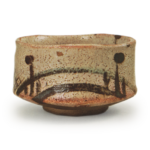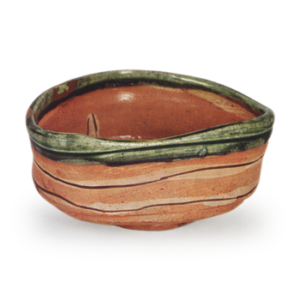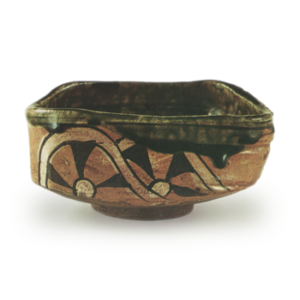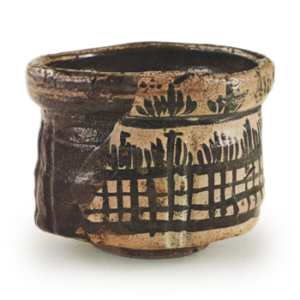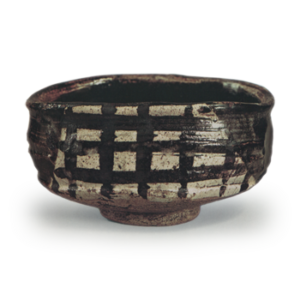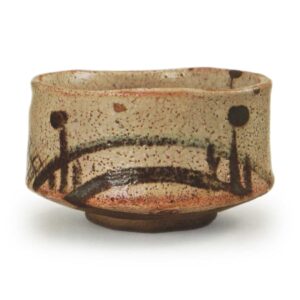
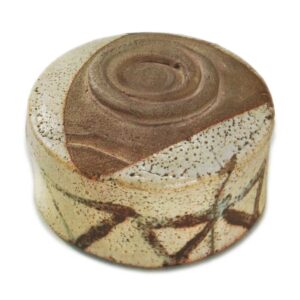
Height: 7.6 to 8.0 cm
Diameter: 12.3 to 12.5 cm
Outer diameter of foot ring: 6.5 to 6.9 cm
Height of foot ring: 0.8 to 0.9 cm
Many Shino tea bowls feature pictures of bridges. These are called Sumiyoshi tea bowls after the Sumiyoshi Shrine, but if you look closely at the simple bridge patterns painted on them, you will see that they vary greatly. Some people say that these patterns are not of bridges, but rather of wheelbarrows and waterwheels. In fact, there are some Shino ware tea bowls with wheelbarrow-like patterns, but it is not thought that these predate the bridge patterns in terms of chronology. As can be seen in the Momoyama folding screens, bridge paintings probably suited the tastes of the time.
It is not easy to decide which is older, for example, whether a bridge has two or three dots on the balustrade like a false jewel, or whether it has a bridge pier or not. Even if they are from the same period, of course, they will be different depending on the kiln and the potter. However, it is possible to say that the older the bridge is, the more relaxed and unhurried it is, and conversely, the more formalized and cramped it is, the more recent it is.
In that respect, I think the painting of the ‘Hashihime’ at the Tokyo National Museum is the most solid. The painting of the house on the opposite side of the bridge is also very well done, and it is not strange to think of it as the Sumiyoshi shrine.
Generally, on the other side of the bridge on a Sumiyoshi-te teacup, there is usually a picture of a house, or a triangle, a mountain shape, a chintz, a hinoki fence pattern, or a calendar pattern. Perhaps, at first, the Sumiyoshi shrine was drawn, but it gradually became simplified, and became a normal house shape, and then changed to a triangle, a mountain shape, and so on.
The most attractive feature of this tea bowl is the beauty of the glaze. The unique glaze of Shino ware, with its bubbling holes, is warm and faintly reddish all over, and the richly protruding waist and mouth are clearly colored a bright orange. The iron-painted colors are also deep and vivid, and the coloring is almost ideal.
The figure has a large, protruding waist and the body slopes down slightly from the torso to the rim of the mouth, but overall it is gentle yet also has a hint of strength and richness. The name “Ushiwaka” is probably derived from this.
The foot ring is a spacious double foot ring. The base is almost a perfect circle, and the triangular clay protrusion caused by the glaze is also perfectly round. The mountain path brush is slowly turning near the waist.
There are three eye marks the size of rice grains on the inside. There is one vertical channel, and there is also a gold repair to fill in a break in the glaze at the mouth of the channel.
It was passed down in the Fujita family of Osaka, and in 1934 it left the family’s possession at the second auction held by the family.
The name “Ushiwaka” was given by Masuda Dono.

